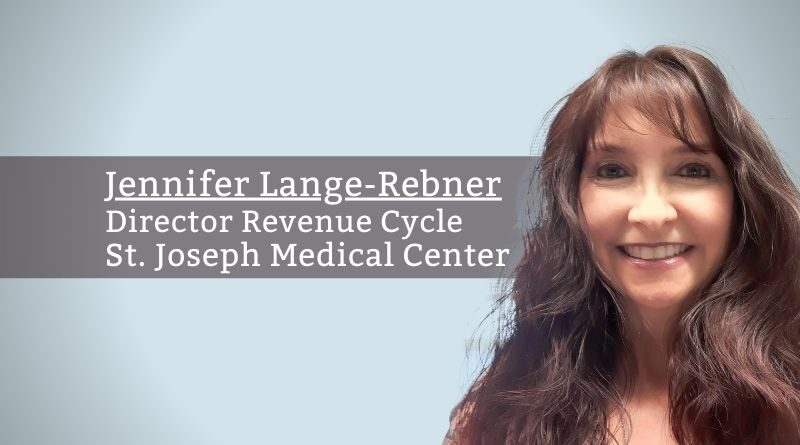Professional Revenue Cycle Management–Where Survival Meets Innovation
By Jennifer Lange-Rebner, Director Revenue Cycle, St. Joseph Medical Center
Revenue Cycle can seem like a complex, dynamic beast with Revenue Cycle leaders feeling the weight of their organization’s financial health sitting on their shoulders. How do organizations begin to master the beast and get paid appropriately for services rendered?
Like an assembly line, defects made upstream impact the quality of the downstream product. Optimizing front end processes will reduce costly downstream re-work and denial of payment. Gathering all upfront information efficiently while ensuring the patient doesn’t feel burdened can be daunting. Yet, some things cannot be corrected downstream and missing the opportunity or entering incorrect information can result in lost revenue. An example is prior authorizations, a common high volume denial category; some payers allow a window for “retro” authorizations, whereas other payers either offer no opportunity or a very short timeframe. Ideally, all prior authorizations would be captured upfront and setting up missed authorization edits for a front end or middle revenue cycle team (i.e., prior to claim submission) would be a good safety net. Appealing prior authorization denials based on medical necessity often doesn’t result in payment, so sound upfront processes are key.
Front end registration errors are another high-volume denial category for many organizations. The majority of registration errors can be fixed via middle revenue cycle edits or by back-end revenue cycle staff appealing registration denials. However, this increases an organization’s cost to collect. Conducting ROI analysis for investing in front-end tools, including real-time eligibility and authorization automation via access to payer information sources, can help reduce that cost. Other front-end tools can significantly improve the patient experience as well as the bottom line. Patient liability estimators and mobile payment options are worth considering to improve cash flow, lessen the cost of back-end patient statements, payment plans, and bad debt, and decrease patient confusion over what they owe as their cost share.
An organization needs executive-level champions as well as provider involvement in order to successfully drive improvement throughout the Revenue Cycle.
Another area of opportunity is documenting clear expectations for our invaluable care providers and holding providers accountable via consequences of not achieving metrics. Revenue Cycle standards for providers may include closing patient encounters within a certain timeframe, so the Coding/Revenue Cycle review process can start. Coding may need to query a provider to ask a question or request a documentation addendum to support services rendered. Holding the provider responsible for responding to queries within a certain number of days minimizes the aging of accounts. In addition, providers are expected to achieve a percent accuracy rate on their documentation and code selection audits. Providers who don’t achieve the required audit score are also held accountable for completing education with Coding Coaches within a certain timeframe.
Another very helpful approach is identifying your “superstar” providers and asking them to function in partnership with the Coding Coaches as Provider Coding Advisors. Peer-to-Peer interaction to discuss documentation, coding, patient workflow, etc., has proven invaluable to achieving lasting change. We know that many providers are overburdened with patient volumes and administrative work, so working smarter is key. Working with the Coding team to understand documentation requirements and with system IT to implement documentation templates and smart phrases help ensure documentation is concise and includes only what’s required to compliantly document services rendered. Some providers need education that more is not always better and to avoid “note bloat.”
Denials mitigation is a huge undertaking that requires an all-hands-on-deck approach. An organization needs executive-level champions as well as provider involvement in order to successfully drive improvement throughout the Revenue Cycle. Provider champions with denial mitigation listed officially as part of their job description should be a very effective strategy. A denial mitigation workgroup/governance committee to prioritize opportunities and execute action plans is recommended. Denial data from payers is vast and complex; therefore, the workgroup should include Revenue Cycle experts to decipher the denial reason codes (which aren’t always used consistently by payers), identify root causes, and recommend action steps for workgroup discussion. Quantifying the net revenue impact of denial reductions is paramount to justify the investment of tools and people. The data will also facilitate the celebration of successes and encourage ongoing momentum.
With the adoption of artificial intelligence (AI) or “bots” in Revenue Cycle for mundane, consistent processes, the Revenue Cycle can repurpose talented people to reduce other high volume work. Additional benefits can be realized through working with system IT to optimize system functionality, engaging with other organizations on the same system to share enhanced functionality, and partnering with AI vendors. One example is the possibility of using a bot to upload documentation to a payer portal. Work with your payers to reduce the footprint of processes to provide payers information to adjudicate claims.
Lastly, educate your organization on how they can contribute to a healthy revenue cycle. I believe the healthiest organizations will foster a culture where staff understand how they contribute to clean, compliant claims and reduce avoidable denials. Encourage staff to express ideas for leaner processes. Share key metrics frequently so staff and others can see how their efforts improve the bottom line. Revenue Cycle is not just a department, but rather is the backbone of financial health that runs through the entire organization. Work together as an organization to tame the beast.



